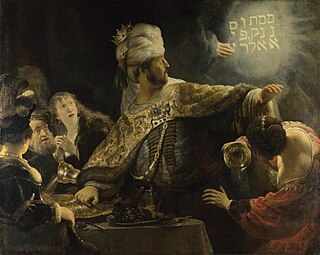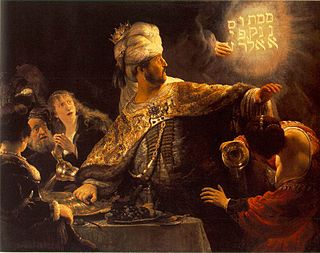 W
WBelshazzar was the son and crown prince of Nabonidus, the last king of the Neo-Babylonian Empire. Through his mother he might have been a grandson of Nebuchadnezzar II, though this is not certain and the claims to kinship with Nebuchadnezzar may have originated from royal propaganda.
 W
WThe Beast of Babylon Against the Son of Hercules is a 1963 Italian-French peplum film written and directed by Siro Marcellini and starring Gordon Scott.
 W
WBelshazzar is an oratorio by George Frideric Handel. The libretto was by Charles Jennens, and Handel abridged it considerably. Jennens' libretto was based on the Biblical account of the fall of Babylon at the hands of Cyrus the Great and the subsequent freeing of the Jewish nation, as found in the Book of Daniel.
 W
WBelshazzar's feast, or the story of the writing on the wall, tells how Belshazzar holds a great feast and drinks from the vessels that had been looted in the destruction of the First Temple. A hand appears and writes on the wall. The terrified Belshazzar calls for his wise men, but they are unable to read the writing. The queen advises him to send for Daniel, renowned for his wisdom. Daniel reminds Belshazzar that his father Nebuchadnezzar, when he became arrogant, was thrown down until he learned that God has sovereignty over the kingdom of men. Belshazzar had likewise blasphemed God, and so God sent this hand. Daniel then reads the message and interprets it: God has numbered Belshazzar's days, he has been weighed and found wanting, and his kingdom will be given to the Medes and the Persians.That very night Belshazzar the Chaldean (Babylonian) king was killed, and Darius the Mede received the kingdom.
 W
WBelshazzar's Feast is a major painting by Rembrandt now in the National Gallery, London. The painting is Rembrandt's attempt to establish himself as a painter of large, baroque history paintings. The date of the painting is unknown, but most sources give a date between 1635 and 1638.
 W
WBelshazzar's Feast, JS 48, is incidental music by Jean Sibelius to a play of the same name by the journalist, poet and playwright Hjalmar Fredrik Eugen Procopé (1868−1927).
 W
WBelshazzar's Feast is a cantata by the English composer William Walton. It was first performed at the Leeds Festival on 8 October 1931, with the baritone Dennis Noble, the London Symphony Orchestra and the Leeds Festival Chorus, conducted by Malcolm Sargent. The work has remained one of Walton's most celebrated compositions. Osbert Sitwell selected the text from the Bible, primarily the Book of Daniel, and Psalm 137. The work is dedicated to Walton's friend and benefactor Lord Berners.
 W
WBelshazzar's Feast is an oil painting by British painter John Martin (1789–1854). It was first exhibited at the British Institution in February 1821 and won a prize of £200 for the best picture. It was so popular that it needed to be protected from the crowds by a railing, and established Martin's fame. In the words of Martin's biographer William Feaver, he "turned literary references to visual reality". Martin published mezzotint engravings in 1826 and 1832. The original painting is now held in a private collection; two smaller contemporaneous "sketches" are held by the Yale Center for British Art in New Haven, Connecticut and the Wadsworth Atheneum in Hartford, Connecticut.
 W
WCiro in Babilonia, ossia La caduta di Baldassare is an azione sacra in two acts by Gioachino Rossini with a libretto by Francesco Aventi. It was first performed at the Teatro Comunale in Ferrara during Lent, 1812. The exact date of the premiere is unknown but is believed to be 14 March. During Lent it was the custom for Italian opera houses either to close or to stage works on themes from the Bible. Ciro in Babilonia is one of two Lenten operas by Rossini and is based on the Biblical story of the overthrow of the Babylonian king Belshazzar by the Persian ruler Cyrus the Great.
 W
WBelshazzar, son of the last king of the Neo-Babylonian empire, Nabonidus, has inspired many works of art and cultural allusions, often with a religious motif. While a historical figure, depictions and portrayals of him are most often based on his appearance in the biblical story of Belshazzar's feast in the Book of Daniel. This story is the origin of the idiomatic expression "the writing is on the wall".
 W
WThe "finger of God" is a phrase used in the Bible. In Exodus 8:16–20 it is used during the plagues of Egypt by the Egyptian magicians. In Exodus 31:18 and Deuteronomy 9:10 it refers to the method by which the Ten Commandments were written on tablets of stone that were brought down from biblical Mount Sinai by Moses.
 W
WIntolerance is a 1916 epic silent film directed by D. W. Griffith. Subtitles include Love's Struggle Throughout the Ages and A Sun-Play of the Ages.